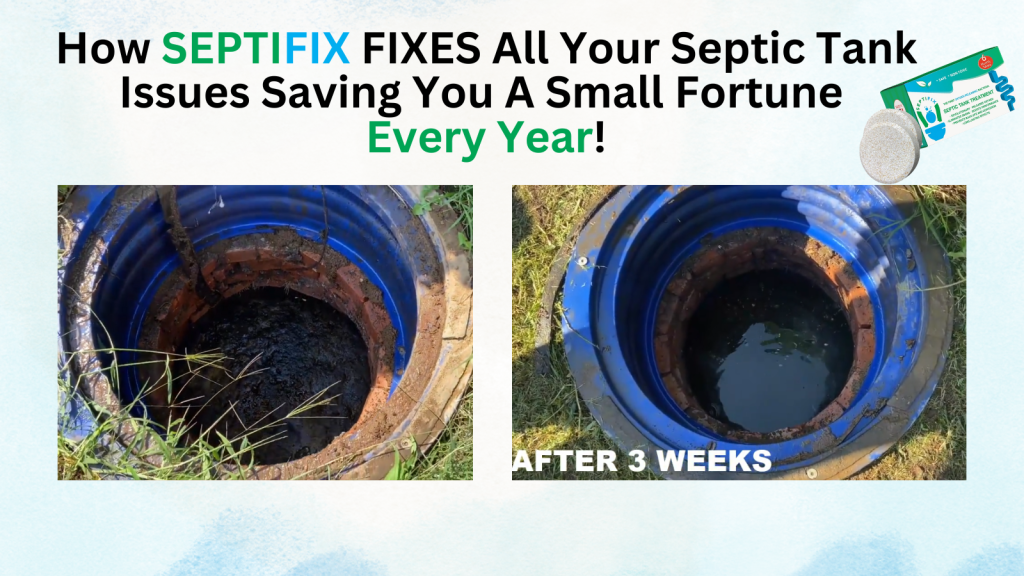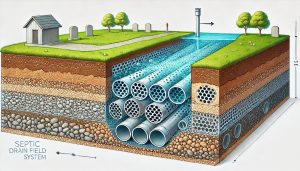If you’re a homeowner with a septic system, DIY septic maintenance can help you avoid expensive repairs and prolong the life of your system. Whether you call it a wastewater treatment unit, on-site system, or septic tank setup, keeping it running smoothly is crucial to your home’s sanitation and property value.
Neglecting maintenance often leads to backups, odors, and costly pump-outs or replacements. Fortunately, a little DIY care goes a long way in preserving system function between professional checkups.
Table of Contents
- How a Septic System Works
- Regular DIY Maintenance Tasks
- What You Shouldn’t DIY
- Seasonal Maintenance Tips
- When to Call a Pro
- Tools and Supplies for DIY Septic Maintenance
- Contact Info and Resources
- Conclusion: Be Proactive with Your Septic System
- FAQs on Septic Systems
- Septifix
- Septic Permit Links by State
How a Septic System Works
Before diving into maintenance, it helps to understand the basics.
Components of a Septic System
- Septic tank: Collects and partially treats household wastewater.
- Drainfield (leach field): Disperses treated effluent into the soil.
- Pipes and baffles: Direct flow and prevent solids from clogging the system.
Understanding these parts can help you spot issues early and perform basic care confidently.
Regular DIY Maintenance Tasks
These DIY steps can be part of your routine to prevent septic failure and avoid unnecessary emergency service calls.
1. Monitor Water Usage
High water flow can overload your system. Try the following:
- Install low-flow faucets and toilets
- Fix leaks promptly
- Spread out laundry loads throughout the week
Even small changes in your water habits can make a big difference in system efficiency.
2. Inspect and Clean Filters
Modern septic tanks often have an effluent filter to catch solids before they reach the drainfield. Cleaning it 1–2 times a year helps prevent clogs. Always wear gloves and eye protection.
Tip: If you’re not sure how to access the filter, check your system diagram or consult a pro once before doing it yourself next time.
3. Use Septic-Safe Products
Household cleaners, detergents, and toilet paper can affect bacterial balance in your tank.
- Use biodegradable, non-antibacterial soaps
- Choose septic-safe toilet paper
- Avoid bleach-heavy or chemical drain cleaners
Maintaining a healthy bacterial environment is essential for breaking down waste naturally.
4. Keep the Drainfield Clear
The drainfield needs to breathe and drain properly. To protect it:
- Don’t park vehicles or heavy equipment on it
- Avoid planting trees or shrubs nearby
- Divert gutters and drainage away from the area
In many regions, this area is also called a leach bed or soil absorption system—same job, same rules.
5. Maintain an Inspection Schedule
Mark your calendar to check tank levels and inspect the drainfield every 6–12 months. A quick walk-through can catch soggy patches, odors, or signs of failure before things escalate.
What You Shouldn’t DIY
Never Pump the Tank Yourself
While checking scum and sludge levels with a stick or probe is fine, leave pumping to professionals. Improper handling poses health risks and may violate local health codes.
Avoid Digging Without a Map
Before digging near your system, always refer to a site plan. Accidentally puncturing a pipe or tank can cause a big mess and legal headaches.
Don’t Ignore Professional Inspections
DIY is great for in-between care, but you should still schedule a professional inspection every 3–5 years. A pro can catch issues hidden underground or inside the tank.
Seasonal Maintenance Tips
Spring
- Inspect the drainfield for wet patches or new growth
- Clean effluent filters
- Test sump pumps and backflow valves if installed
Summer
- Spread out water usage if guests visit
- Watch for slow drains—may indicate early clogs
Fall
- Divert rainwater away from the tank and drainfield
- Winterize plumbing in unused structures
Winter
- Avoid compacting snow over the drainfield
- Insulate access ports if needed to prevent freezing
When to Call a Pro
Even the most diligent DIYer should know when it’s time to call in a licensed septic specialist:
- Persistent odor near the tank or drainfield
- Sewage backing up into the home
- Water pooling over the drainfield
- Loud gurgling noises from plumbing
- It’s been over 3–5 years since the last pump-out
Don’t wait until you have a full-blown emergency. Early help is usually cheaper—and safer.
Tools and Supplies for DIY Septic Maintenance
Here’s a basic toolkit you might need for safe maintenance:
- Long plastic or wooden sludge measuring stick
- Effluent filter brush or hose
- Rubber gloves and eye protection
- Septic-safe toilet paper and household products
- System layout diagram
- Record book for inspections and pump-out dates
Contact Info and Resources
Want help finding a pro or learning more about your system? Check out:
- EPA SepticSmart — National guidelines and homeowner resources
- Your local health department — For permits and approved installer lists
- National Onsite Wastewater Recycling Association (NOWRA) — Find certified professionals
- OdorFreeSeptic.com — Learn about eco-friendly septic care and odor solutions
Conclusion: Be Proactive with Your Septic System
DIY septic maintenance doesn’t replace professionals, but it gives you more control over your system’s health and your household budget. By keeping an eye on water use, maintaining the tank and drainfield, and staying alert to warning signs, you’ll reduce your risk of unexpected (and smelly) surprises.
Take action today—grab a calendar, set a maintenance reminder, and walk your drainfield. Your future self (and your wallet) will thank you.
FAQs on Septic Systems
How do I know if my septic system is failing?
Look for slow drains, foul odors, or standing water near the drain field.
Can I skip septic tank pumping if I maintain it myself?
Nope! Regular pumping every 3–5 years is a must, even with top-notch maintenance.
Are additives for septic tanks really necessary?
They’re not mandatory, but they help maintain healthy bacteria levels, especially if you use a lot of cleaning products.
What happens if I ignore septic maintenance?
Ignoring it can lead to backups, leaks, and expensive repairs—or worse, total system failure.
Can I save money by doing all the maintenance myself?
Absolutely! While you’ll still need a pro for pumping, regular DIY maintenance saves you from bigger expenses down the road.
Septic Regulations in Rural Areas: Essential Guide for Rural Property Owners
The Role of Perforated Pipes in Drain Fields
What Happens During a Pumping Service?
Septic Tanks vs. Sewer Systems | Choosing the Right Option
Directory | Virginia Septic Service Providers | Part 2
Directory | Virginia Septic Service Providers : Best Professionals | Part 1
Septic Treatments for Odor Control: Best Methods for Eliminating Unpleasant Smells
How to Maintain a Healthy Bacteria Balance | Tips to Ensure Your Septic System Has the Right Microbial Environment
Septifix










